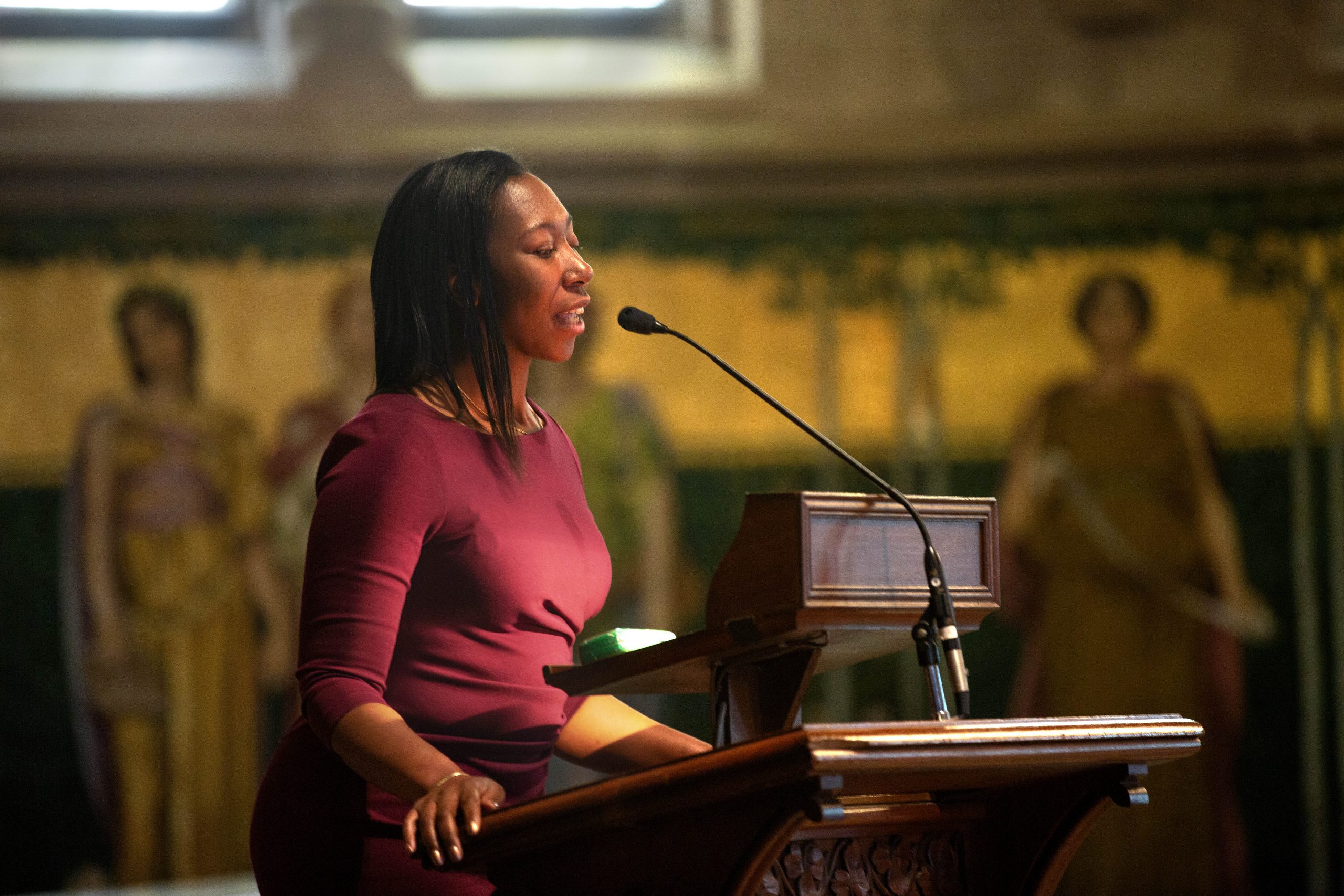Angela Winfield was 6 years old when the Americans with Disabilities Act (ADA) was signed into law in on July 26, 1990. She was still too young to understand what the law meant, but not too young to be among the one in four Americans who live with a disability.
At age 4, she was diagnosed with juvenile rheumatoid arthritis, glaucoma, cataracts and uveitis, an inflammatory disease that destroys eye tissue. At age 10, despite surgeries, she lost the vision in her left eye, and was declared legally blind. By age 20, the vision in her right eye deteriorated and she lost all sight.
Her dream was to be a lawyer. “But I’d never seen anybody practicing law who looked like me — a blind, Black woman,” she says. She came up with role models to emulate: Her parents, who were both teachers; guidance counselors; Oprah; and Stephen Hawking, because not only did he have a “very visible disability, but he was also very successful in his field.”
The role models were great motivation. Winfield earned her law degree from Cornell University, and after being in private practice, returned to Cornell as associate vice president for inclusion and workforce diversity. Earlier this year, she became the chief diversity officer for the Law School Admission Council (LSAC), the not-for-profit organization that is best known for administering the Law School Admission Test and is working on improving quality, access and equity in law and education worldwide.
We have a significant portion of our community that doesn’t have the same level of access that we all take for granted in this new world of remote work.
When Winfield took the LSAT years ago, the LSAC provided a person to read the questions for her and to write her answers. “Now, individuals like myself who have visual impairments or who are blind and use a computer screen reader are able to use that software that they’re familiar with to take and navigate the test,” she says. “A live reader is not required. But you can still request it.
“The ADA itself has done wonders for accessibility in terms of providing a legal framework and basis for requiring accessibility,” Winfield says. “But one of the things I always say is that ADA is the floor” and not the ceiling.
On this 31st anniversary of the ADA, a landmark civil rights law for people with disabilities, there is much to commend and still room to do more, say advocates like Winfield and others.
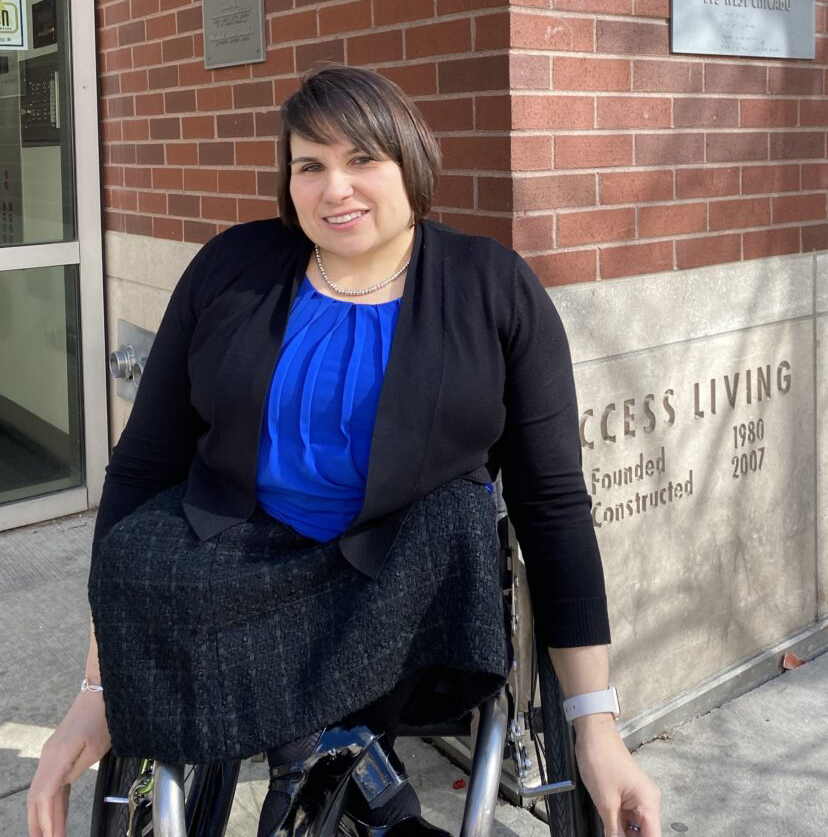
The pandemic “has given us a much sharper view because it has exposed so many disparities that disabled people have long faced,” says Karen Tamley. Photo courtesy of Access Living.
“Particularly with this pandemic, it has given us a much sharper view because it has exposed so many disparities that disabled people have long faced,” says Karen Tamley, president and CEO of Access Living, a Chicago-based nonprofit that focuses nationally on housing and civil rights issues for persons with disabilities, as well as providing independent living skills and peer support at the local level.
Among the disparities Tamley cites: the digital divide.
“I see it every day in our work, the number of people with disabilities that still don’t have connectivity, broadband, don’t have devices, don’t have digital literacy comfort levels, don’t have email addresses – or don’t have accessibility in terms of assistive technology and access to accessible information or web sites,” she says. “We have a significant portion of our community that doesn’t have the same level of access that we all take for granted in this new world of remote work.”
Tamley was born with caudal regression syndrome, the abnormal development of the lower end of the spine. Doctors told her parents she would never be able to sit up or leave home on her own. She proved them wrong.
She remembers her father having to carry her into stores and restaurants because prior to the ADA, there were no requirements for ramps or curb cuts for those using wheelchairs.
“Growing up I wasn’t able to ride the local city bus, because it wasn’t accessible, and there was no requirement on lifts,” Tamley says. “And then fast forward to seeing how many changes there have been in this world to benefit disabled people that are really significant. I always feel like the ADA anniversary is an opportunity to reflect on those gains. But it’s also a time where we need to look forward on what still needs to be done.”
For example, a provision in the U.S. Fair Labor Standards Act still allows people with disabilities to be paid below minimum wage. The rate of employment for persons with a disability is already low – 17.9 percent in 2020, compared to 61.8 percent for persons without a disability, according to the U.S. Bureau of Labor Statistics.
“A lot of Americans don’t realize that people with disabilities can be paid less than minimum wage,” says Jessica Rafuse, an attorney and Microsoft’s director of strategic partnerships and policy for accessibility. “And when I say less than minimum wage, I mean cents on a dollar.”
To counter that, Microsoft requires its suppliers to pay employees no less than minimum wage.
Rafuse, who was also an administrative judge for the U.S. Equal Employment Opportunity Commission, has muscular dystrophy and uses a power wheelchair.
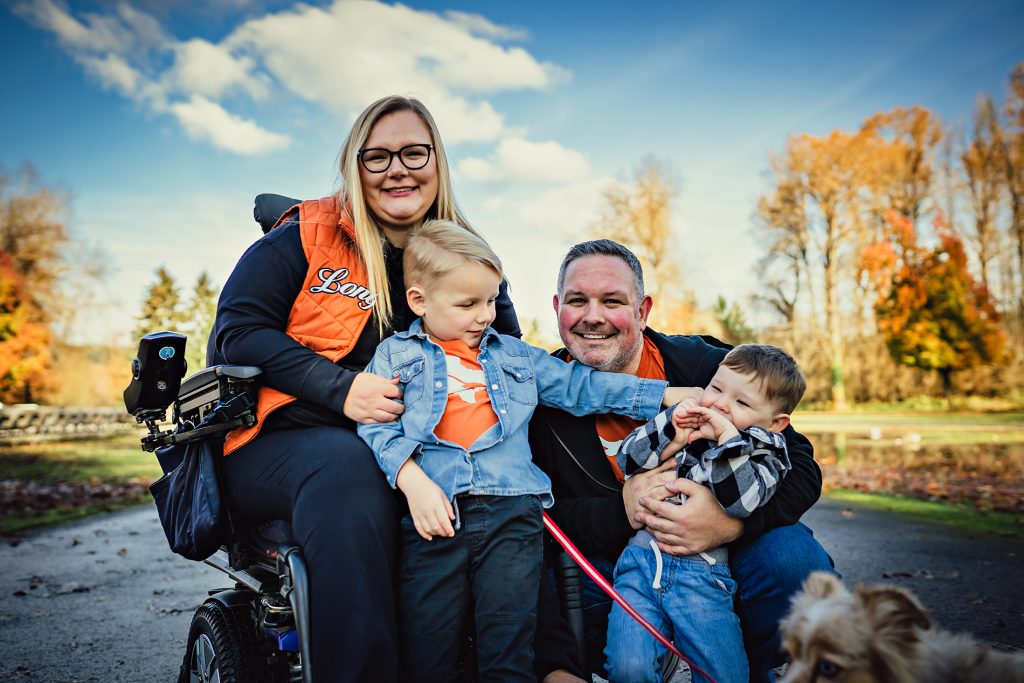
“The ADA was a law that opened doors for me – literally – creating ramps up to those doors so that I could access things like employment, reasonable accommodations, going to a restaurant,” says Jessica Rafuse, shown with her husband and their two boys. Photo courtesy of Jessica Rafuse.
“The ADA was a law that opened doors for me – literally – creating ramps up to those doors so that I could access things like employment, reasonable accommodations, going to a restaurant,” she says.
A lack of equity in the areas of technology, employment and education is known as the “disability divide,” a term used by The World Bank.
To help bridge that divide, Microsoft recently started a pilot program as part of its Airband Initiative in Los Angeles and New York City for people with disabilities that offers a bundle of services – hardware, software, broadband internet – at low-cost financing. Microsoft is also exploring how it can better support nonprofits that focus on people with disabilities and accessibility issues, Rafuse says.
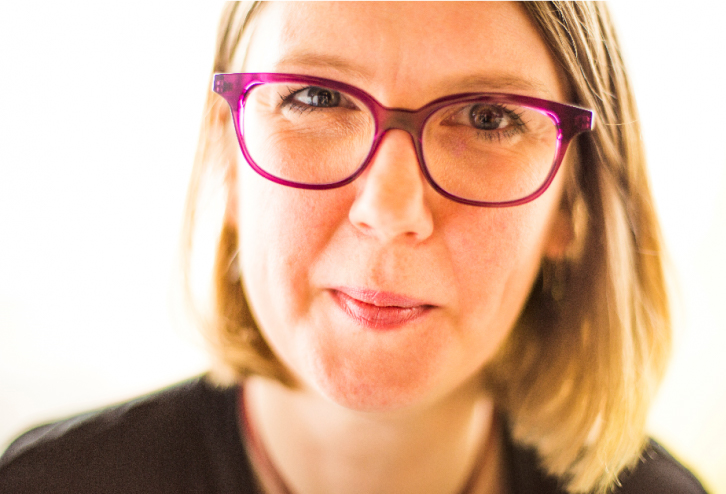
“We’ve got to get more technology into people’s hands and educate people on the power of accessibility,” says Jenny Lay-Flurrie, Microsoft chief accessibility officer.
“We’ve got to get more technology into people’s hands and educate people on the power of accessibility,” says Jenny Lay-Flurrie, Microsoft chief accessibility officer. “Digital accessibility has accelerated in the last five years, there is so much now built into software like Windows and Office.”
Another Microsoft effort will be a low-cost assistive technology grant program. “Some people have coined the term ‘disability tax,’ because it can be so much more expensive to be a person with a disability,” Rafuse says. For example, her wheelchair and van to transport the wheelchair totals more than $100,000.
“All of these costs that people with disabilities experience are contributing to a disability tax,” she says.
To ease the burden, Victor Calise, commissioner of the New York City Mayor’s Office for People with Disabilities, thinks it’s important for cities to “go above and beyond the ADA in many respects.”
Like in New York City, where he says the city’s building code and Human Rights Law exceeds federal requirements and has written inclusive design and inclusive recreation guidelines to provide technical assistance to designers that help them meet and exceed their ADA requirements.
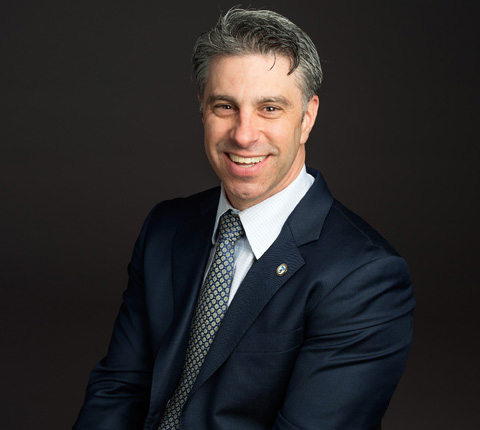
“If people with disabilities are not seen, they are not heard and if they are not heard they are not seen,” says Victor Calise, commissioner of the New York City Mayor’s Office for People with Disabilities.
The city is also working to make websites and digital platforms accessible to people who use screen readers; that accessible pedestrian signals are included on many streets; induction loop systems for people with hearing difficulties are in place in many taxis and city projects; and LinkNYC kiosks, which provide free phone calls, Wi-Fi and device charging, also have accessibility features including access to American Sign Language interpreting.
“A truly inclusive ‘smart city’ will ensure that all technology includes the needs of the disability community from the very beginning of the design process,” says Calise, who has used a wheelchair since a mountain biking accident in 1994 left him paralyzed from the waist down.
“If people with disabilities are not seen, they are not heard and if they are not heard they are not seen,” he says. “It is important for accessibility to be discussed in the mainstream at all levels of discourse. People with disabilities are the largest minority in the U.S. and the world, and we need to be included in all aspects of society.”
Top photo: Angela Winfield, speaking at Cornell University. Photo credit: Jason Koski/Cornell University

